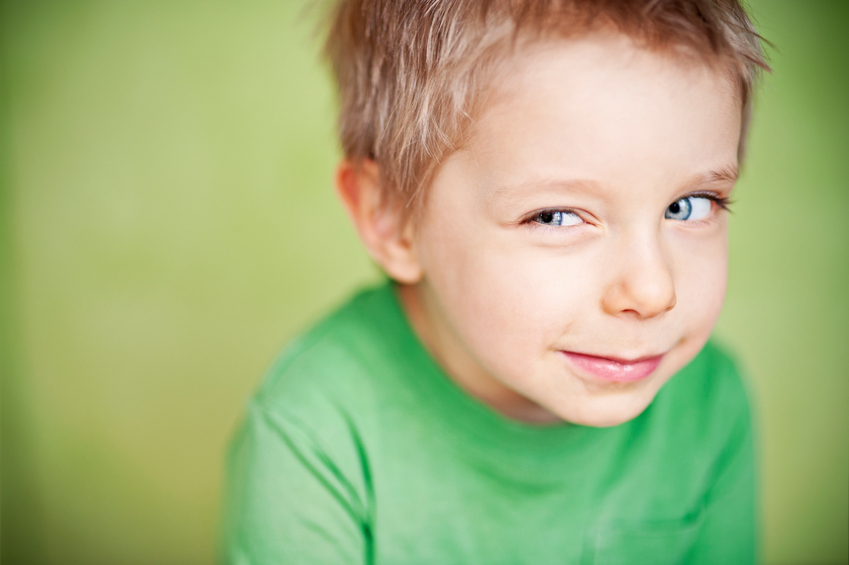To study lying in children, Lee and his colleagues use a simple experiment. They ask kids to guess the identity of toys hidden from their view, based on an audio clue. For the first few toys, the clue is obvious -- a bark for a dog, a meow for a cat -- and the children answer easily. Then the sound played has nothing to do with the toy. "So you play Beethoven, but the toy's a car," Lee explains. The experimenter leaves the room on the pretext of taking a phone call -- a lie for the sake of science -- and asks the child not to peek at the toy. Returning, the experimenter asks the child for the answer, following up with the question: "Did you peek or not?"
为了研究孩子们的说谎行为,李和他的同事做了一个简单的实验。他们要求孩子们根据声音线索猜出那些不被他们看到的玩具究竟是什么。孩子们很容易回答出头几个玩具,因为线索显而易见,例如狗吠和猫叫。然后研究人员播放一些与玩具无关的声音。“你放的是贝多芬的音乐,但玩具是一辆汽车。”李说。试验中,实验者为了测试的科学性而借口打电话离开房间 ,并要求孩子不要偷看玩具。 回来后,实验者问孩子们答案的同时也紧跟着问:“你偷看了吗?”
Most children can't resist peeking, Lee and his researchers have found by monitoring hidden cameras. The percentage of the children who peek and then lie about it depends on their age. Among two-year-old transgressors, only 30 percent are untruthful. Among three-year-olds, 50 percent lie. And by eight, about 80 percent claim they didn't peek.
李和他的研究人员发现,绝大多数的孩子们抵抗不住偷看的诱惑。偷看并撒谎的孩子所占的百分比取决于他们的年龄。在两岁的违规者中,只有百分之三十是不诚实的。在三岁之间,谎言占到了50%,到8岁,则有80%的人声称他们没有偷看。
Kids also get better at lying as they get older. In guessing the toy that they secretly looked at, three- and four-year-olds typically blurt out the right answer, without realizing that this reveals their transgression and lying. At seven or eight, kids learn to mask their lying by deliberately giving a wrong answer or trying to make their answer seem like a reasoned guess.
随着年龄的增长,孩子们也越来越会撒谎。在猜测偷看过的玩具时,三四岁的孩子通常会脱口而出正确答案,而不会意识到这样会暴露他们的谎言。到了七岁或八岁,孩子们故意给出错误的答案,或试图让回答看起来像一个有理由的猜测,从而掩饰自己的谎言。

Five- and six-year-old kids fall in between. In one study Lee used Barney the dinosaur as the toy. A five-year-old girl who denied having looked at the toy, which was hidden under a cloth, told Lee she wanted to feel it before guessing. "So she puts her hand underneath the cloth, closes her eyes, and says, 'Ah, I know it's Barney,' " Lee recounts. "I ask, 'Why?' She says, 'Because it feels purple.' "
五岁和六岁的孩子则在两种情况之间。在一项研究中,李使用巴尼恐龙作为玩具。一个五岁的女孩否认偷看过放在衣服下面的玩具,她告诉李,她想在猜测之前感受到物体。 她把手放在布下面,闭上眼睛,说:“啊,我知道是巴尼。”李问:“为什么?”她说因为感觉到紫色。
What drives this increase in lying sophistication is the development of a child's ability to put himself or herself in someone else's shoes. Known as theory of mind, this is the facility we acquire for understanding the beliefs, intentions, and knowledge of others. Also fundamental to lying is the brain's executive function: the abilities required for planning, attention, and self-control. The two-year-olds who lied in Lee's experiments performed better on tests of theory of mind and executive function than those who didn't. Even at 16, kids who were proficient liars outperformed poor liars. On the other hand, kids on the autism spectrum -- known to be delayed in developing a robust theory of mind -- are not very good at lying.
孩子设身处地为他人着想的能力的发展驱动着这种谎言诡辩的增长。像被人熟知的心智理论那样,这是我们为了理解他人的信仰、意图和知识而获得的能力。说谎的根本在于大脑的执行功能:规划,注意和自我控制所需的能力。在李的实验中,说谎的两岁儿童比那些没有说谎的在心智理论和执行功能的测试中表现得更好。 即使在十六岁,精通骗术的孩子也在测试中表现得更好。另一方面,自闭症儿童并不擅长撒谎,人们认为他们在形成一种健全的心智理论时被耽搁了。












